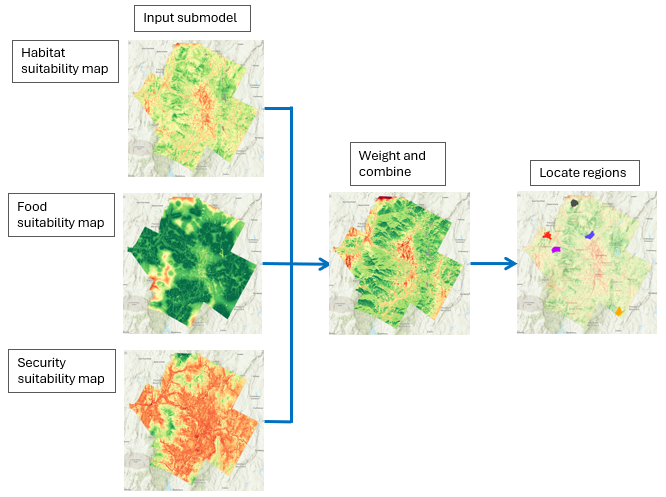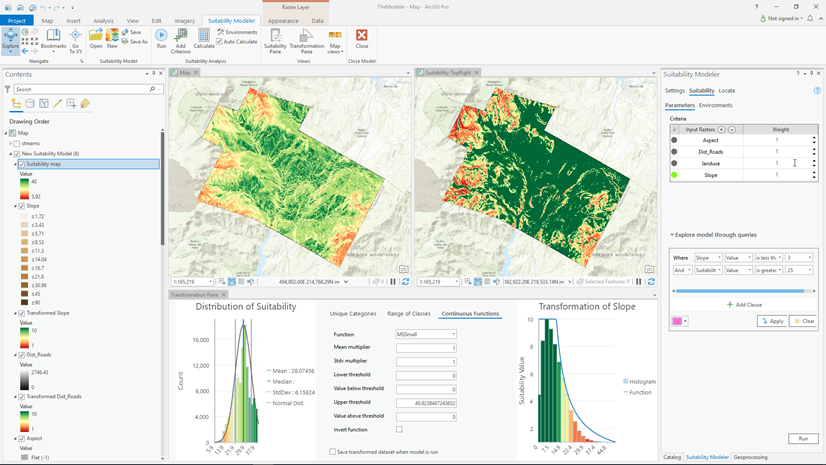When creating a suitability model, the overall goal must be clearly defined. To reach the goal, most times the subject must make tradeoffs between multiple objectives. To meet each objective, the subject responds to several criteria. Through these criteria, the subject satisfies each objective and collectively, the objectives allow the subject to reach their overall goal. Submodels in the Suitability Modeler allow you to better capture the tradeoffs between the different objectives.
Often, the overall goal and the objectives to meet the goal are not clearly defined. If the goal and objectives are not articulated, then it is difficult to identify the criteria for the model. Each criterion must help the subject meet a specific objective.
Whenever you add any criterion to a suitability model, make sure that you understand what the reason is for the criterion. For example, in a simple suitability model for locating a downhill ski area that does not have clearly defined objectives there might be three criteria, slope, distance to roads, and distance to water. It is important to ask if the slope criterion is defining which slopes are better to ski on or is it identifying the locations that are more costly when building the lodge? Similarly, is the distance from roads meant for accessibility for the skiers or is it aimed at reducing construction costs? Finally, is the distance to water intended to minimize the cost of snow making or is the focus for providing water for the lodge?
Once the criteria for an objective are identified, the next step is to transform the criteria values onto a common suitability scale to capture how the subject is responding to the values relative to the objective. The transformed criteria maps are added together to create a suitability map identifying the preferences for each location relative to the objective (see The general suitability modeling workflow). However, if the objective is not clearly defined, it will be difficult to transform the criterion values onto the suitability scale.
For the ski area example, the overall goal and objectives may be:
Overall goal: To be profitable
Objectives to meet that goal:
- Have good terrain to ski on
- Reduce construction costs
- Ensure access to the resort
In this example, the slope criterion might be entered twice, once to meet the terrain objective and the second for the construction cost objective. Utilizing submodels for each of the objectives may be a more effective approach for this model.
Use submodels in the Suitability Modeler to capture multiple and more complex objectives and the tradeoffs between them. Each submodel can define the subject’s decision making from the perspective of one of the specific objectives. The suitability maps generated from each submodel are then combined to identify the tradeoffs the subject makes between the objectives so they can reach their overall goal.
The number of criteria that should be included in each submodel is determined by the objective. However, a rule of thumb is, each submodel should contain about 3 to 6 criteria. If the objective requires many more criteria, you may want to split the objective into two, narrowing the scope of each of the objectives.
Let’s look a little deeper by creating a suitability model using submodels to capture the tradeoffs a bobcat makes to survive.
Using submodels
We want to develop a suitability model to identify the optimal areas to conserve for bobcat.
Overall goal: To save a minimum viable population that ensures genetic diversity for the next century
Objectives for the bobcat to meet the overall goal:
- Good habitat to live and reproduce – the necessary physical conditions
- Have access to food
- Stay safe
We will create three suitability submodels, one for each objective: 1) Habitat, 2) Food, and 3) Security.
Next, we identify the criteria for each submodel allowing the bobcat to meet the objectives. First, specify the criteria that captures the bobcat’s preference for the best areas to live in. Then define the criteria that allows the bobcats access to food. Finally, identify the criteria that ensures the bobcats are safe.
The Habitat submodel might include the following criteria:
- Land use – certain land use types, such as forests, are more preferred
- Distance to streams – need access to water, closer the better
- Solar radiation – since the study area is in a cold climate, warmth is important
- Distance from conserved areas – the conserved locations will add to the contiguous habitat
The Food submodel might include the following criteria:
- Land use – specific land use types have a greater number of prey
- Distance to wetlands – wetlands have a high diversity of prey
- Distance from deer yards – in winter, deer shelter in these areas
- Distance from agriculture – in times of need, fields may attract certain prey
The Security submodel might include the following criteria:
- Distance from roads – it is safer farther from the roads
- Distance from houses – the farther the better
- Slope – the steeper areas will provide more escape possibilities
- Viewshed – the less seen the better
The suitability map from the Habitat submodel identifies the best areas to live in and to reproduce. While the suitability map from the Food submodel defines the most likely areas the bobcat will find food. And the suitability map from the Security submodel identifies where the bobcats are the safest.
The suitability maps from the three submodels are combined to create a composite suitability map to capture the tradeoffs the bobcat will make balancing the three objectives. In the resulting aggregated suitability map, a location with good habitat and food but is unsafe may not be desired. Depending on the study site, certain objectives might be more important than others, such as when food is limited, the food submodel may then be assigned a higher weight.
Finally, the locate step (see Locate tab in Suitability Modeler) is run after the three submodels are combined to identify the actual areas to preserve. These areas are best suited to conserve for bobcat.

In the bobcat model, the bobcats are making tradeoffs between multiple objectives to survive and reproduce. Let’s look at another application for submodels.
Working with domain experts
Here we will examine how submodels can be used to incorporate science from domain experts. The resulting submodels can be used by decision makers to explore various policy scenarios.
Problem: Identify the best site for a solar farm
Overall goal: Produce as much power as possible and make a profit
Objectives captured by submodels:
- Solar Gain – identify areas that receive the most solar gain
- Cost of construction – minimize costs
- Environmental considerations – have low impact on the environment
When developing this comprehensive model, different experts can contribute submodels based on their area of expertise. The solar engineers can create the Solar Gain submodel. The civil engineers can create the Cost of Construction submodel. And the biologists can create the Environmental considerations submodel. The science does not change so the decision makers should not alter these submodels.
However, the decision makers can combine the submodels created by the experts and assign various weights to each to explore different policy scenarios. For example, they may want to apply a higher weight to the Environmental considerations submodel if the natural world is most important. Or they may have a limited budget, so they may want to weight the Cost of Construction submodel higher. The decision makers can see how each policy scenario affects the final output.
Submodels allow you to create more complex models that captures the full decision making of the subject. They also keep your model focused; with each criterion that is entered, it has a clear purpose.
The more accurately you can capture the subject’s decision making, your resulting decisions will be more informed.


Article Discussion: